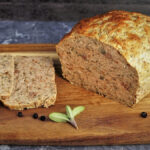
Haslet: pork and sage meatloaf
An old fashioned and much-loved English pork, sage and onion meatloaf or terrine. Best eaten cold and sliced in sandwiches, with pickles and salad. Slices can also be fried and eaten as part of a cooked breakfast.
Ingredients
- 1 large onion roughly chopped
- salt to taste
- 150 - 200 ml milk
- 80 g breadcrumbs or cubes of stale bread
- 10 g lard or butter melted
- 500 g minced pork avoid lean mince
- 25 g pig's liver, finely chopped OPTIONAL see Recipe Notes
- 1 large egg
- ¼ tsp ground white pepper
- ¼ tsp ground black pepper
- 2 - 3 tsp dried sage or double the amount of fresh sage
Instructions
-
Preheat your oven to 200 C / 180 Fan / Gas 6.
-
Put the chopped onion in a small saucepan with a pinch of salt and cover with boiling water from a kettle.
Simmer until soft (8 - 10 min) then drain, cool under running cold water then drain again. Squeeze between your hands to remove as much water as possible.
-
Pour milk over the breadcrumbs or diced bread, stir so it's submerged and leave to soak for a few minutes. Squeeze between your hands to remove as much milk as possible.
-
Use some of the melted lard or butter to grease a small baking dish or loaf tin.
-
Mixing the ingredients: for a fine texture use a food processor. Otherwise, mix in a bowl using your hands.
Combine the pork mince with the liver if using, the squeezed dry bread and onions, the egg, ¾ tsp of salt, the black and white peppers, plus 2 tsp of sage. Ensure that the ingredients are thoroughly mixed.
Take a teaspoon or two of the mixture, shape into a patty or ball and fry in a little oil until cooked through. Cool a little then taste: add more salt, pepper, or sage to the remaining mixture if needed.
-
Transfer the mixture to the prepared baking dish or loaf tin. Form into a loaf shape, pressing together well to avoid gaps: traditionally the top is slightly domed.
Brush with more of the melted lard or butter.
-
Put the baking dish or loaf tin in a deep roasting tray and pour boiling water from a kettle into the tray until it comes halfway up the sides.
-
Transfer to the oven and cook for 1 hour or until the juices run clear when a skewer is inserted.
Optional (for a darker top): for the final 5 - 10 minutes discard the tray with the boiling water and turn the temperature up to 220 C / 200 Fan / Gas 7.
-
Remove from the oven and leave to rest for 15 minutes.
Pour off any juices (use in gravy, stock, or just drink it) then carefully tip out the haslet onto a board.
Leave to cool.
-
Slice when completely cold and serve on sandwiches or with salad and pickles.
Can also be served hot from the oven or fried.
Eat within 3 - 4 days or can be frozen.
Recipe Notes
Optional Liver. Although haslet would traditionally have been made with offal, these days it rarely contains any. I prefer just a little (25 grams of pig's liver) which adds complexity of flavour without giving a strong offal taste but leave out if you prefer. Alternatively, if you like it, you can replace up to half of the pork mince with liver.